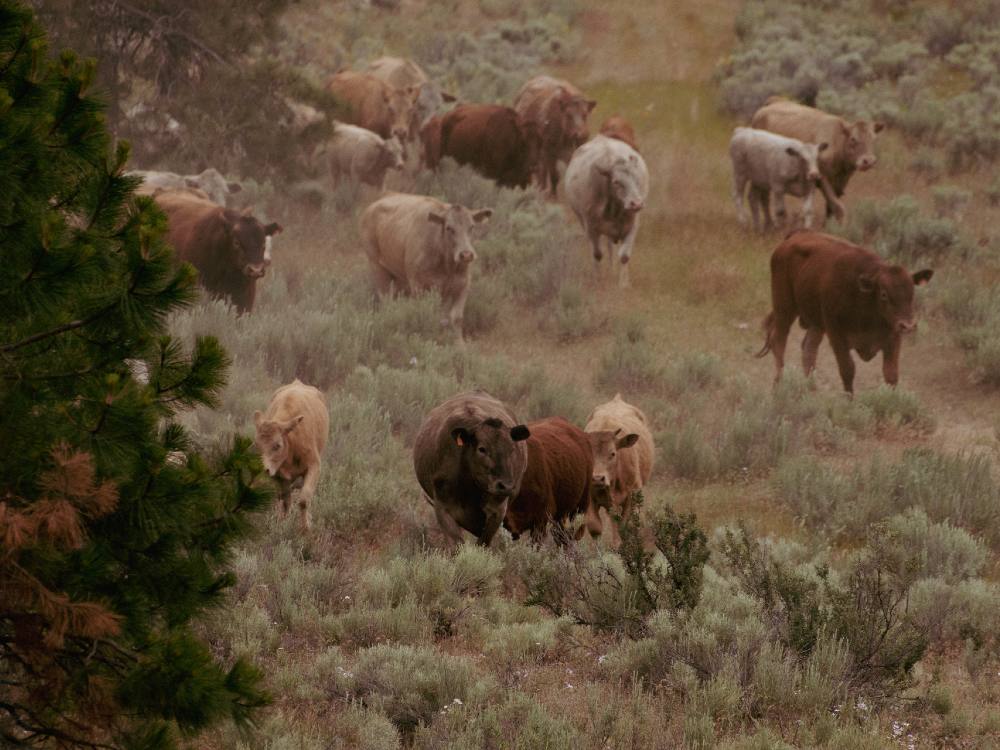At 4 o’clock in the morning Keith Manders watched from his bedroom window as the 2018 Mount Eneas wildfire crested the mountain and raced down the slopes towards his house.
Manders is a cattle rancher born and raised in the Okanagan. He knew forest fires. But he didn’t expect the fire to come over the mountain, and especially not that fast.
“Now I know how fast that fire can move,” said Manders. “It was a real lesson to me.”
Firefighters managed to get the blaze under control before it hit Mander's property, but he was left feeling exposed. Which is why he jumped on an opportunity to control fires using the two resources at his disposal: cows and land.
Starting in 2019, Manders has grazed 150 pairs of mothers and calves on a stretch of land on the north flank of Summerland. Scattered around this pasture are cages, underneath which ungrazed grass grows. When Manders moves the cow to different pastures after a few weeks, researchers come and compare the ungrazed grass and the grazed.
Manders’ Summerland plot is just one of three plots of land used in a targeted grazing pilot project. The others are in Kelowna and Cranbrook, surrounded by houses, vineyards and golf courses.
The project’s cows eat grass that would otherwise yellow and dry out across the summer, removing what would normally become volatile fodder for fires in July and August.
The strategy can be compared to mowing the lawn. Mowed lawn stays green longer, and is therefore less prone to fire.
“Our biggest objective is to prove that we can reduce fire behaviour by grazing cattle,” said Mike Pritchard, the project’s co-ordinator and a former employee of BC Wildfire Services, where he worked on fuel management strategies. “And we’re doing that by keeping [the grass] green for longer, kind of like mowing the lawn.”
The initiative wrapped up its third year a few weeks ago. So far the results are promising. Areas grazed by cattle contain 25.5 per cent less plant biomass, with pinegrass heights reduced by 34 per cent. This means, Pritchard says, forest fires will not have the fuel to move as quickly.
Pritchard also predicts that grazing has reduced the period of “combustible grass” from two months (July and August) to one month (August).
“You’re never gonna be able to stop fire unless it’s pouring rain,” said Pritchard. “So it’s not about eliminating the fire, it’s all about keeping the intensity level down so fire crews can actually deal with it.”
The initiative is part of a move to rethink wildfire management practices.
Over the past two decades, wildfires in the B.C. Interior have been controlled by thinning dense conifer stands, said Pritchard. However, this technique didn’t work. The increased sunlight and rain only lead to more grass between the trees.
“We just exchanged one fuel type for another,” said Pritchard. “We got rid of the conifers but we were growing grass and grass is one of the most volatile fuel types in the province because it moves so quickly.”
Other preventative methods, such as controlled burning, don’t work well in urban settings — it’s logistically difficult and risky, and the smoke is also a nuisance and threat to the health of nearby residents.
By comparison, cows remove fodder for fire without the nuisance, danger and without replacing one fuel for another.
But if the strategy is to be effective at preventing fires near urban centres, it must be scaled up. To do this, they need to make it commercially viable.
Grazing cattle next to urban centres is costly. For example, fencing in B.C. can cost up to $20,000 per kilometre, depending on the landscape. In places where it’s dry and hot in the summers, reservoirs also need to be built to provide cows with water.
It is also more expensive and inefficient for ranchers, who typically haul cattle to more remote Crown land for the summer, where fencing is not necessarily required and there are natural sources of water. The cows will graze in these pastures until the frost and snow drives them back down the mountain. In comparison, grazing cattle next to urban centres requires ranchers to move them every few weeks, which costs gas, time and labour.
While the majority of the current project has been funded by the BC Cattlemen’s Association, this would not be an option if scaled up.
Manders predicts that grazing his cattle in this way would add about $10,000 in annual costs, who says that this strategy is very different from running cattle on wide-open land like the caribou.
“You have to have pretty good infrastructure to make it work,” he said.
The key to implementing this on a large scale will be larger plots of land that stretch — undisturbed — into Crown land, Pritchard said. That way ranchers would not need to haul cattle. It would also create a larger barrier for the fire.
But carving off large swathes of land for cattle grazing would require the collaboration of municipalities right at a point when many of these communities, especially Kelowna and Cranbrook, are expanding.
Nevertheless, these preventative costs are minimal when compared to the cost of fighting a large-scale wildfire. For example, a medium-sized water-dropping helicopter costs $19,733 per hour.
“It doesn’t take long for a large fire to cost millions per day,” said Andrew Hunsberger, a planner with the City of Kelowna. “Any prevention work is a drop in the bucket, especially when we consider the cost of wildfires to business and our tourism industry.”
Preventing fire is also about more than protecting property. In British Columbia, extreme fire years in 2017 and 2018 each produced three times more greenhouse gases than all other sections of the province combined, according to the provincial greenhouse gas emissions inventory.
Cattle grazing on grassland might also have benefits that stretch beyond forest fire management.
“Our beef industry is fundamental to helping to conserve our grasslands,” said Cameron Carlyle, a researcher at the University of Alberta who is the head of a $3.5 million project examining the carbon sequestration of grasslands. He also sits on the board of the Saskatchewan Stock Growers Foundation, a land conservation charity that is connected, but distinct, from the Stock Growers Association, which promotes and helps ranchers.
According to Carlyle, grasslands, which are Canada’s most endangered ecosystem, sequester and store huge amounts of carbon. But the majority of these grasslands in Canada are privately owned and at threat of being cultivated and turned into cropland, a process that would release up to 50 per cent of the sequestered carbon into the atmosphere.
As a director of the Saskatchewan Stock Growers Foundation, Carlyle has been part of initiatives to stop the cultivation of grasslands. For example, the foundation works to provide term conservation easements and payments to grassland owners; however, these are often turned down because the money does not compete with the profit that can be reaped from cultivating crops, especially crops like canola, which are currently seeing record high prices.
Raising cattle, Carlyle argues, financially incentivizes landowners to keep their grasslands intact.
“Landowners are looking for revenue, and that's either going to come from beef production or it’s going to come from crops,” said Carlyle. “So having cattle on the landscape is keeping our native grasslands as native grasslands.”
Carlyle argues that in Canada, where the majority of cows are pastured on grasslands, the benefits of cattle ranching on grasslands outweigh the environmental cost of the methane produced by cattle.
Nearly 10 million cattle are raised for beef every year in Canada, according to 2016 census data. All the beef on the shelves of Canadian supermarkets is from either Canadian or U.S. producers, with Alberta and Saskatchewan the two largest producers. In fact, Canada exports 2.5 per cent more beef than it imports from the U.S.
The majority of Canadian beef is partially grain-fed, meaning that at some point the cows were fattened in feedlots with high-energy grains like corn and barley. But regardless of where they spend their final four months, cows in Canada are almost always born and raised on pasture before being transferred to a feedlot. The Canadian beef industry therefore relies on grasslands.
“When we think about our beef production cycle, it relies on our perennial vegetation in either native or in untamed pastures,” said Carlyle. “This is because it’s a relatively inexpensive source of forage. It’s a critical part of beef production.”
Carlyle did point out that this environmental calculus doesn’t translate to the global context. For example, according to the World Wildlife Fund, cattle ranching accounts for 80 per cent of current deforestation throughout the Amazon.
“One of the common criticisms of the beef industry is that it is low efficiency and uses lots of land,” said Carlyle. “But when analyses like these are done, they’re often done at a global scale and they miss some of the finer details of local geography… when you think about Canada a lot of that is being done on native grasslands, which could [without ranching] be turned into something else.”
Carlyle’s research also suggests that the grasslands benefit from the grazing of cattle because these ecosystems evolved with the disturbance of fires, as well as grazing bison and pronghorn. Cattle grazing, when done responsibly, mimics the way bison used to graze, trampling the grass and therefore producing a mix of vegetation types and heights on pastures, which in turn promotes biodiversity and leads to the sequestration of more carbon.
For example, Grasslands National Park in Saskatchewan recently started allowing ranchers to graze within the park for a reduced fee, provided they also kept private grasslands for grazing. The park hoped that it would promote biodiversity and species at risk.
“We’ve lost bison, we don’t like the risks associated with fire, so one of the only practical, large-scale ways to apply the disturbance is cattle grazing,” Carlyle said.
Back in Summerland, Keith Manders is hard at work managing his cows up on Crown land, and growing hay that will be harvested in the fall to feed the cattle in the colder winter months.
The Interior has had an unusual amount of rain this summer, so Manders is not too worried about fire this year. But he’ll never stop thinking about it. He still keeps his eyes on the mountain.
“It’s a type of insurance,” he says. “We’re always grazing.” ![]()
Read more: Food, Environment
















Tyee Commenting Guidelines
Comments that violate guidelines risk being deleted, and violations may result in a temporary or permanent user ban. Maintain the spirit of good conversation to stay in the discussion.
*Please note The Tyee is not a forum for spreading misinformation about COVID-19, denying its existence or minimizing its risk to public health.
Do:
Do not: